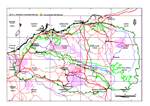Click on images
to enlarge



Photographer: E. Thoma

Photographer: B.R. Maslin

Photographer: B.R. Maslin

Photographer: B.R. Maslin

Photographer: E. Thoma

Photographer: E. Thoma
, E Thoma 1235, lab photo by Fiona McCallum ADJUSTED_sml.jpg)
Seed from one herbarium voucher. Scale in mm. Photographer: F. McCallum.
Botanical name
Acacia affin. clelandii
Description
Obconic shrubs or trees 4-7 m tall, with a single trunk or sometimes dividing at ground level into 2-3 main trunks, the trunks and branches slightly crooked, crowns sub-dense and light green. Branchlets terete, finely ribbed at extremities (ribs not or only slightly raised, sometimes slightly resinous), hoary with minute, straight, closely-appressed silver hairs between the ribs, aging glabrous. New shoots vernicose by a relatively thick layer of shiny, non-sticky resin, mid-brown (when fresh) but drying dark brown, covered at initiation with microscopic, circular, red-brown resin hairlets (but obscured by the resin), the hairlets becoming sparse as the shoot expands. Phyllodes narrowly linear, 6-12.5 cm long, 1.5-2 mm wide, flat, not rigid, ascending to erect or sometimes wide-spreading, sub-straight to shallowly incurved or wavy, obscurely appressed-hairy (hairs difficult to see without magnification), pure light to mid-green; finely multi-striate with numerous, ±wide, longitudinal nerves of uniform prominence; apex curved to sub-uncinate, terminating in a brown, innocuous hardened brown tip; pulvinus 1.5-2 mm long, yellowish. Gland situated on upper edge of phyllode 0-1 (-3) mm above the pulvinus, submerged within the lamina which is slightly swollen about the gland, phyllode occasionally slightly kinked at the gland. Inflorescences simple, mostly 2 per axil; peduncles 3-6 mm long when in flower, to 11 mm in fruit, resinous, glabrous or with minute and obscure, appressed, straight, silvery hairs and red-brown, microscopic resin hair-like structures (which become sparse when in fruit); spikes obloid to short cylindrical, 8-10 mm long (when dry), light golden; receptacle glabrous. Flowers 5-merous; sepals 1/3-˝ length of petals, free, linear-spathulate; petals glabrous; ovary glabrous. Pods narrowly oblong, 5-7.5 cm long, 8-13 (-16) mm wide, flat but slightly raised over seeds, straight-edged or shallowly constricted between seeds, straight to shallowly curved, coriaceous to slightly sub-woody, resinous, glabrous or with minute and obscure, appressed, slivery hairs, dull mid-brown, obscurely longitudinally reticulately nerved; margins slightly thickened but no intra marginal nerve developed, stipe 5-6 mm long. Seeds longitudinal to longitudinally oblique in pods, obloid-ellipsoid, (6-) 8-9 mm long, (4.5-) 5.5-6 mm wide, flattened (2 mm thick), dark brown to blackish but often paler coloured near the centre, shiny to sub- shiny; pleurogram obscure, "u"-shaped with opening toward the hilum; areole small (about 1 mm long and 0.5 mm wide); funicle thread-like, abruptly expanded into a thickened, white, sub-terminal aril.
Characteristic features
Shrubs or trees with a single or few main stems, the stems and branches slightly crooked and crowns sub-dense. Branchlets finely ribbed at extremities, the ribs sometimes slightly resinous. Phyllodes narrowly linear, 6-12.5 cm long, 1.5-2 mm wide, flat, not rigid, pure light to mid-green; finely multi-striate with numerous, ±wide, nerves of uniform prominence. Gland situated near distal end of pulvinus, submerged within phyllode lamina which is slightly swollen about the gland. Spikes short (8-10 mm). Pods narrowly oblong, long and broad (5-7.5 cm x 8-13 (-16) mm), flat but slightly raised over seeds, coriaceous to slightly sub-woody, obscurely longitudinally reticulately nerved, margins slightly thickened, not winged. Seeds longitudinal to longitudinally oblique in pods, large (mostly 8-9 x 5.5 mm), flattened; aril white and sub- terminal.
Distribution and ecology
Known only from the Pilbara region of northwest Western Australia where it occurs in a restricted area northwest of Paraburdoo, over a distance of about 10 km. Grows on flats and stony plains associated with a tributary of the Ashburton River, in sandy loam with clay at a shallow depth. Common associates include Mulga (A. aneura), A. kempeana , A. tetragonophylla and A. synchronicia.
Flowering and fruiting period
Because of the paucity of collections it is difficult to accurately assess the flowering and fruiting periods for this species. Furthermore, it is likely that flowering and fruiting are influenced by the timing and intensity of rainfall events. The specimens at hand were collected in November and December during which time most plants were with flowers at anthesis and in inflorescence bud (presumably in response to late winter rainfall) with a few also possessing pods with mature seeds.
Taxonomy
This entity is a member of the taxonomically complex Mulga (A. aneura and relatives) group. Its taxonomic status is uncertain but it may have some affinities with the more southerly and widespread species A. clelandii, however, this presumed relationship needs further investigation.
Affinities
The growth form of A. affin. clelandii resembles that of the highly polymorphic A. aneura which is most readily distinguished by its generally smaller and more thinly textured pods, smaller seeds and longer flowering spikes.
Conservation status
There is insufficient information at present concerning this entity to justify including it on the Department of Environment and Conservation's Declared Rare and Priority Flora List.
